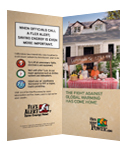Residential Overview > Energy Saving Tips >
Cooking Tips
No Cost
- Cook during temperate hours. Avoid preparing meals that require you to use the range or oven extensively on hot days. This helps to reduce the load on your air conditioner and makes you feel more comfortable in your home.
- Cook with a full oven. Prepare dishes together when possible. If you have three dishes to be cooked in the oven at slightly different temperatures (325°F, 350°F and 375°F, for example), pick the average temperature (350°F in this case) to cook all three.
- Don't peek. Every time you open the oven door to look at the food, the oven temperature is lowered by 25°F to 75°F. Use a timer if the oven door does not have a window.
- Keep oven and burners clean and kitchen ventilated. A clean oven uses energy more efficiently.
- Minimize or eliminate preheating. Don't preheat the oven if the food requires more than one hour of cooking time.
- Use cooking time wisely. Turn off the electric range two to three minutes before the task is done and allow the residual heat to finish the job.
- Use leftover heat as a food warmer. Turn off oven immediately when finished cooking. Ovens retain heat for up to 30 minutes after they have been turned off.
- Use microwave ovens to save energy. Microwave ovens are about 33% more efficient than convection ovens and 66% more efficient than conventional ovens.
- Use the broiler when possible. The broiler uses less energy, and preheating is not required.
- Use the right sized pot on stove burners. A 6" pot on an 8" burner wastes over 40% of the burner's heat. Also, cover pots and pans to keep heat in.
Low Cost
- Double your recipe — and freeze half for later. Reheating uses less energy.
Good Investment
- Choose a stove range with burners that fit a variety of pan sizes. Energy is wasted if you use a small pan on a large burner.
- Electric ranges containing ceramic, halogen or induction range elements are more efficient than the type containing electric coils. They are also easier to clean and allow for greater temperature control.
- Select a self-cleaning oven. It's better insulated than other models, so they are more energy-efficient when used appropriately.
- Select ovens with windows. This allows you to check food without opening the door. Look for self-cleaning features (ensures additional insulation) and electronic or programmable models with timers (for a more precise use of cooking energy).
- Use convection units in combination with conventional ovens. This combination cooks faster at lower temperatures.










